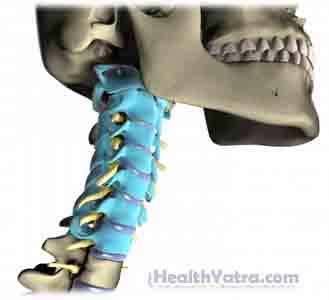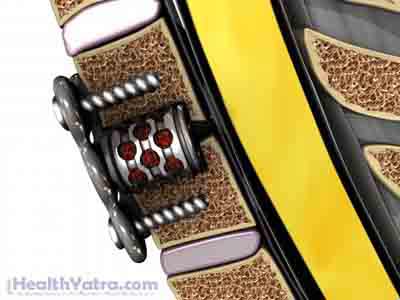Definition
Cervical myelopathy is damage to the part of the spinal cord that is in the neck. The cervical spine begins at the base of the skull. It extends to the first seven vertebrae.

Causes
Cervical myelopathy is caused by:
- Slipped disk
- Cervical disks that are worn (degeneration)
- Tumors inside the spinal cord or compressing on the spinal cord
- Bone spurs
- Dislocation or fracture of the neck
- Traumatic injury to the cervical spine
- Autoimmune disease (eg, transverse myelitis, multiple sclerosis, neuromyelitis optica)
Risk Factors
Risk factors that increase your chance of developing cervical myelopathy include:
- Infections
- Ischemia (restriction of blood supply)
- Autoimmune disorders (eg, rheumatoid arthritis, multiple sclerosis, neuromyelitis optica) or other conditions (eg, vascular disease, degenerative disease)
- History of bone or back problems
- Being born with a narrow spinal canal
- Job or sport involving regular stretching and straining of spine
Symptoms
If you have any of these symptoms, do not assume it is due to cervical myelopathy. These symptoms may be caused by other conditions.
- Pain in shoulder and arms
- Tingling or numbness in arms and legs
- Trouble walking or balancing
- Muscle weakness
- Problems flexing neck
- Dizziness
- Problems with fine motor control (eg, buttoning a shirt)
- Irregular movements
- Bowel or bladder problems
- Weakness below waist or in all four limbs
Diagnosis
Your doctor will ask about your symptoms and medical history. A physical exam will be done. It will focus on any muscle weakness. A neurological exam may also be done to check your:
- Reflexes
- Vision
- Mental state
Your doctor may need images of structures inside your body. This can be done with:
- X-ray
- MRI scan
- CT myelogram
Other tests include:
- Electromyography (EMG) to measure the electrical activity that the muscles generate
- Somatosensory evoked potentials to evaluate the conduction of the nerves in the spinal cord
- Visual evoked potential test (VEP) to test for problems in the brain that affect vision
Treatment
Talk with your doctor about the best treatment plan for you. This may involve:
- Treating the cause of the myelopathy
- Improving functions that you have lost
- Reducing or managing pain
- Doing strengthening exercises
- Teaching you ways to reduce injuries
- Helping you learn ways to cope with the condition
Surgery
If there is structural pressure on the spinal cord, you may need surgery right away. This is to attempt to avoid lasting injury. There are many different kinds of surgery and procedures to stabilize the neck, such as:
- Diskectomy —a surgical procedure to remove part of an intervertebral disc that is putting pressure on the spinal cord or nerve root
- Laminectomy —a surgical procedure to remove a portion of a vertebra, called the lamina
- Fusion of the vertebrae

Nonsurgical Approaches
Your doctor may recommend that you do:
- Physical therapy
- Occupational therapy
- Other approaches, such as ultrasound therapy, heat therapy, electrical stimulation
- Plasmapheresis
Medication
Your doctor may prescribe:
- Non-steroidal anti-inflammatory drugs (NSAIDS)
- Corticosteroids
- Rituximab —This is an antibody used to treat some autoimmune disorders.
Other medications that effect the immune system are also sometimes used.
Prevention
It is difficult to prevent this condition. Follow these guidelines to prevent accidents and strains:
- At work, ask about ergonomics in your workplace. Some examples of ergonomics include learning correct lifting techniques, improving your posture, and sitting correctly.
- Avoid contact sports if you have had disk disease with compression of the spinal cord.
- Limit neck movement.
- Take these measures to prevent falls:
- Remove throw rugs and other obstacles from the floor.
- Install a night-light near stairs and your bed.
- Install handrails in the tub and shower.
- Rise slowly from a sitting or lying position.

